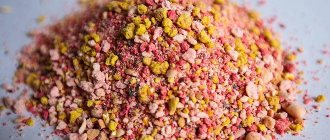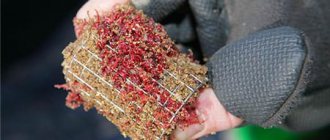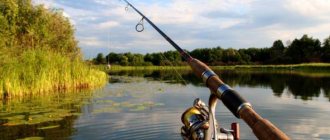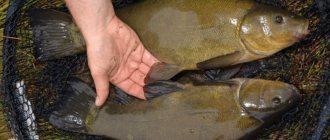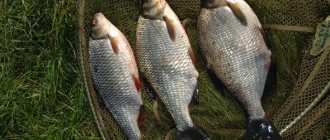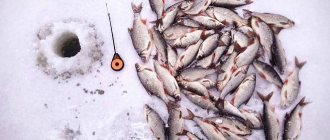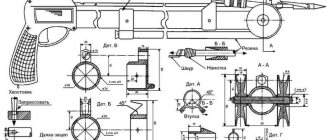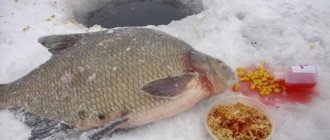Spring, as a roach fishing season, varies significantly depending on weather conditions. In addition, the spawning run occurs during this period. Therefore, for convenience, we will divide roach fishing into 3 stages in the form of months - March, April, May.
We’ll also talk about float, feeder or bottom fishing. Let's not forget about bait and lures. And for a snack - what bait to choose in the spring.
- Roach fishing in March
- Roach fishing in April
- Roach fishing in May
- Roach on a float rod
- On the feeder or donk
- Baits and lures
- Mechanics and composition of bait mixtures for spring roach
A selection of inexpensive fishing rods - click. (the link leads to a separate article “selection”.)
Roach fishing in March
In early spring, in March, in some regions the water bodies were not yet free of ice. This article will talk about fishing for roach in liquid water.
For lovers of winter fishing, a separate material has been prepared - “catching roach on the last ice.”
Despite the fact that on the last ice the roach adheres to the coastline and shallow water areas, immediately after the ice melts it moves a little further away.
At temperatures up to 8 degrees, the roach stands between the center of the channel and the edge, occasionally approaching the border of that very edge.
On deep water lakes, reservoirs and river floods, spring roach stands a little further away, the distance varies depending on the total depth. Approximately about 20-40 meters.
It is quite difficult to give general information that will be useful to all Russian-speaking fishermen. Still, this is not one country, and Russia is big - different weather conditions, different living conditions... Therefore, it is more correct to focus on the reports of fishermen in your region. For this, we have created a special section with a map and reports exclusively on roach, here it is - “where to catch roach”.
You can not only analyze and study, but also help others by leaving your report. Here - “add report”.
DIY bait recipes for roach
Even a novice angler can cope with preparing bait for spring roach fishing, since there is nothing complicated about it. Below we will consider various recipes that allow you to obtain a mixture suitable for various fishing conditions.
Bait recipe for deep fishing
To catch roach located at great depths, it is recommended to use the following bait preparation recipe:
- Mix bread crumbs, corn flour, wheat bran and crushed clay in equal proportions, which must first be dried. If there is no clay, you can use fairly viscous soil.
- Finely grind the cookies or biscuit, the amount should be one part less than the main mixture.
- A small amount of bloodworms and small maggots is added; their volume can be slightly reduced or increased depending on the expected size of the prey.
- Add a small amount of table salt and a small pinch of cumin, which has a pleasant aroma for roaches.
- All components are thoroughly mixed to obtain a homogeneous mass.
Recipe for passive roach
Sometimes the roach has a rather passive behavior and does not want to pay attention to the bait used.
In this case, you need to prepare bait according to the following recipe:
- The base of the mixture is 3 parts rye bran and 2 parts rye crackers, which must first be crushed.
- Add 1 part each of wheat bran, corn flour and hemp seeds to the mixture, which will also need to be crushed.
- Add 0.5 parts each of pigeon droppings and caddis flies, which can be replaced with bloodworms.
- A few pinches of coriander and a small amount of table salt are added, after which the resulting mass should be mixed thoroughly.
Recipe for fishing at shallow depths
If roach fishing occurs at shallow depths, then it is best to use the following bait preparation recipe:
- The basis of the mixture is crackers made from wheat bread. Take 3 parts of this component.
- Cookies are added to the breadcrumbs, which should be pre-crushed. Its quantity should be 1 part less.
- Add 1 part each of corn flakes and cereal.
- Auxiliary components are taken in 0.5 parts, these are sunflower and flax seeds, which are pre-crushed; pigeon droppings; sunflower cake; bloodworm.
- One tablespoon of ground black pepper and several tablespoons of beta-carotene are added to the resulting mixture.
The resulting mixture demonstrates excellent results if prey is caught at a depth of no more than 1.5 meters. It is possible to add a small amount of crushed cloves to the composition, in which case it will attract not only roach, but also bream.
Salapinskaya porridge
Salapin porridge is a good bait option for roaches, especially when using a feeder as the main tackle
The detailed recipe for its preparation is described below:
- You need to put a 4-5 liter pan on the fire, pour 4.5 cups of water into it.
- You need to wait until the water boils, after which no more than half a mug of pearl barley is poured into it.
- Now you will need to monitor the cooking process, as soon as the water becomes cloudy and the edges of the grains noticeably darken, you need to start mixing the bait, gradually pouring a mug of millet into it.
- After a few minutes, the main aromatic components are added: two tablespoons of sunflower oil and no more than 15 grams of vanillin.
- The porridge is thoroughly mixed, after which it must be left on low heat for further cooking.
- When holes appear in the cooked mixture and the water disappears, remove the pan from the heat and cover it with a lid.
- After 20 minutes, inspect the porridge: if a small amount of water remains, it must be drained.
- Now add a mug of barley grits and 1.5 mugs of corn grits, the porridge is mixed again.
The result should be a crumbly porridge that will serve as an effective bait for spring roach. If its friability is not sufficient, it means that the proportions of the ingredients were chosen incorrectly, in which case you will need to add more cereal.
Roach fishing in April
The April period can be called the most critical period in roach fishing. Even at the beginning, the water is often not warm enough for the pre-spawning run. Therefore, the March conditions seem to be layered.
When the temperature warms up to 8-10 degrees, the long-awaited roach run begins. At such a time, the roach approaches the shore: - beds of medium and large rivers (10-12 meters) - beds of small rivers (almost close) - lakes, reservoirs and spills (variably, from 10 to 20)
At a temperature of 11-14 degrees, spawning begins, which lasts about 2 weeks. During spawning time, roach does not stop pecking, but it is better to refrain from fishing.
During the mating season, roaches come very close to the shoreline of reeds and other grass.
Roach fishing in May
It is possible that roach spawning may occur in May, so we will be guided by the weather.
Roach practically does not need rest after mating games. Therefore, the bite stabilizes almost immediately. As a rule, from mid-May the roach completely switches to summer mode.
Here she stays near the reed thickets, hiding from a strong current, if there is one. On lakes and reservoirs, depending on the depth, it can stand both in the coastal zone and at some distance. But as a rule, up to 15 meters - no further.
Here are a few favorite places for roaches in spring in May:
- Reed edge.
- The shell is at the bottom, where food is retained well.
- Visits haunted places, but does not stay for long. Risk of a lurking predator.
- Small elevations in the relief, the so-called tables or navels.
- Occasionally, especially large roaches move to the middle of the edge. Can stand in the water column.
- Bays with a gentle current.
Catching roach on a feeder or donk
When equipping bottom tackle with a feeder or sinker, it is important to understand that roach is not a large fish, and sometimes bites are barely noticeable. This is especially important when fishing in the current. In spring, the flow speed is always slightly higher than in summer or autumn.
If you missed the information about where to look for roach, specific areas. It is highly recommended that you read it above, starting here.
You can increase the sensitivity of your gear with the right equipment:
- Use braided cord with a diameter of 0.12 - 0.14 mm. The braid does not stretch, so it transmits the bite better.
- When installing a feeder or sinker, it is better to use a symmetrical loop.
In-line editing also conveys the bite well.
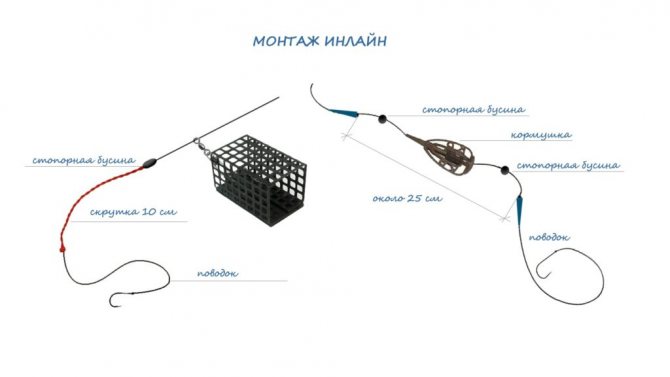
In an in-line installation, a 10 cm twist between the main line and the leash helps the feeder not get tangled.
Techniques and tactics for feeding small and large roach in spring
First of all, having settled down on the shore, you need to feed the place. If the fish will be caught using a float, you need to make several balls, the size of which will correspond to the size of an ordinary orange, and then throw it into the pond.
Immediately after this, you should begin to deal with gear, equipment and settle in place. This pause will help attract roaches.
The roaches are fed with small pellets. It is important at this moment not to overfeed the fish.
Features of feeding during the current
When fishing using float gear, the mixture in the form of bait must be thrown upstream. The composition of the bait is washed out over time and at the same time creates a stream where hooks with bait wait.
You should take into account not only the direction, but also the strength of the current, as well as the various existing turbulences. To obtain the required viscosity, use ordinary soil.
Little tricks
To make fishing effective and enjoyable, you should consider the following:
- It is necessary to feed the place only in small portions, in the meantime, the feeding time should be at least 15-30 minutes;
- too much bait can distract the fish from the bait itself;
- Old components should not be used to prepare the mixture; they should all have a pleasant and fresh smell;
- You should not overuse flavorings, since the strong aroma repels the fish.
Let's sum it up
Spring fishing can be effective and vice versa, so it can both please the angler and, on the contrary, greatly upset him. Here it doesn’t matter at all how the preparation of the process took place, what gear was chosen, what position was taken, and whether the selected composition of the bait could seduce and lure the fish.
When preparing, even a small miscalculation for fishing in the spring can turn into disappointment.
It is necessary to select the right bait and bait. You should also check the sensitivity of the gear so that during fishing they can feel the careful bite of the fish.
Spring baits and roach baits
In early spring, before spawning, meat baits work best. And not large in size. These include:
- From one to three moths.
- One maggot.
- A worm, but not a large one, thin. Sometimes even pieces.
- Caddisfly.
- Winter bait is the larva of the burdock moth.
When the water warms up, you can try to enlarge the bait. In addition, plant attachments are included:
- Corn.
- Semolina chatter.
- Various types of dough.
- Pearl barley.
Bait for roach in spring
This section is not devoted to recipes; it is much more important to understand the mechanics and its relativity to the behavior of roaches during a certain period of spring.
Click here for the recipe.
Early spring, cold water
At such times, heavy feeding is not advisable. The roach gets full quickly. To avoid overfeeding, mixing bait with soil (soil, clay) will help.
It is advisable to select the color of the bait to match the shade of the underwater soil. Black - for a muddy bottom, light - for a sandy bottom.
It is better to exclude the presence of a large faction. This can be done by purchasing special winter bait for roach, or by sifting through a fine sieve.
It wouldn’t hurt to add a little bait, the same one we catch with. But be careful, the task is to put the fish on point, and not to feed it from the belly.
During the current, the bait should be “heavy”. This can be done by diluting with earth or clay. As an exception, it is permissible to use finely divided cereals, such as millet. It’s not necessary to choose a muddy or light one here - the flow will blow you away anyway.
When standing still, we exclude the entire large fraction. We also add a little bait to the bait itself. In addition, the mixture should become dusty and cloudy.
Bait in warm spring water
Warm spring water is much more loyal to the fisherman and forgives mistakes. The roach feeds actively and takes the bait more confidently.
Everything described in the section above is relevant, but not with some assumptions, namely:
- It is not necessary to match the color of the bait to the bottom soil.
- Mixing with the soil can be left only for the flow. But it is better to use heavy mixtures or porridges.
- You can add bait to your bait without fear.
- Adding a large fraction is acceptable, or even desirable, when there are trophy roach in the reservoir. For example - corn, pearl barley, small pellets.
- When fishing with a float rod, the bait in still water must be active and turbid. Since the fish can stand in the water column without picking up food from the bottom.
- On the riverbed, muddy and dusty bait can only be used in small backwaters and on the backwaters (turn of the current near the shore).
We hope that these tips will help you figure out how to catch roach in the spring.
Back to
“Roach fishing”
Coloring of bait
To obtain bait of the desired shade, two different methods are used. The first method is to add components that can lighten or darken the components in the bait.
For example, for lightening you can use:
- milk corn;
- regular bran;
- wheat crackers;
But in order to darken the bait they add:
- dark-colored soil;
- rye crackers;
- copra;
- hemp.
In addition, you can use an artificial method, that is, adding food coloring. The best option is considered to be one that uses lightening components.
Roaches mainly feed at mid-water. Therefore, lumps of the nutrient mixture should disintegrate in two to three minutes. Any fishing begins with a fairly plentiful feeding of the place where the fishing will be carried out.
Afterwards, at the time of fishing, it is necessary to feed the roach, it is advisable to do this immediately after the fish is caught with balls of bait, the size of which is comparable to the size of an ordinary walnut. By the way, all further fishing is based on this.
In fact, of course, there are exceptions, so you should always experiment. After all, a professional fisherman is an experienced catcher.
